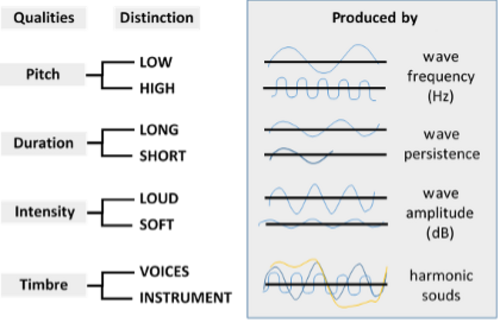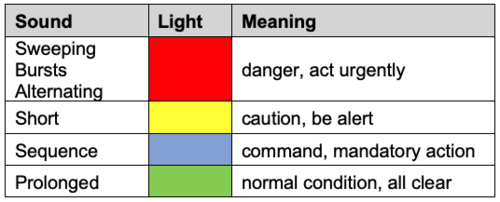Display Design Principles – Auditory Displays
General requirements
Auditory displays may emit sound with different quality characteristics (Figure 1). These characteristics are related to frequency, intensity (loudness), duration, pitch of sound or in the duration of the intervals between discrete sounds.
In safety-related or urgent tasks, simultaneous use of visual and auditory displays is preferable compared to single type display. Human perception is improved when acoustic signals are combined with visual signals (e.g., red flashing light and siren) (Figure 2).
When the visual tasks of the operator have saturated the visual channel, auditory displays shall be used. Presentation of auditory signal is a correct choice also when immediate action is necessary such as information presented on the display calls for immediate action or when the operator shall act while perhaps being far from control stations. Auditory displays are suitable when ambient illumination conditions make critical seeing unreliable, when a critical seeing task requires continuous monitoring, but further information needs to be imparted at the same time, or when signal detection (at threshold visual conditions) needs to be reinforced.
Auditory signal characters shall be chosen according to importance or urgency. Use of more than two different lengths of sound in each sequence shall be avoided. For example, in dangerous situations, signals with frequency variation are preferable such as sweeping or alternating.
Auditory display sound pressure level above 80 dB(A) shall be avoided.
Auditory displays shall not be used, when ambient noise levels are very near or exceed discomfort levels, when too many other audio signals are being retrieved, or when characteristic noise from machinery and other devices is quite similar to the planned auditory display.
Auditory warning signals should be
- easy to hear above background noise or other auditory signals (e.g., at least above 10 db above ambient noise level).
- discriminable from each other and other auditory signals,
- compatible or consistent with other standard signals already in use,
- attention getting and holding, but without traumatic distraction from other possibly sensitive or critical performance functions.
- non-masking in the sense of drowning out other auditory signals equally important of the overall operation.
- provided with separate emergency power source.
Specific requirements
Auditory display designs should support tasks as follows:
- Detection: Among the primary factors affecting detectability is change in the surrounding sound pattern, since change will gain the operator's attention. Hence, short and repeated sounds (such as two-tone auditory displays) are preferable alerts and are more reliably detected even in high noise environments. Safe detection of other auditory signals (e.g., when switching latching controls) requires low sound pressure levels of the operational environment.
- Identification: Displays shall be clearly distinguishable from all other sounds in the environment, with specific changes in the existing sound pattern relative to acoustic properties of the surroundings (e.g., pressure level, frequency spectrum, variations in amplitude and/or frequency, timbre, repetition, rhythm, and melody). Perceived urgency is another factor affecting identification. Urgency of information presentation should be expressed by, for example, a higher frequency and/or a rapid tempo. Perceived urgency of the display shall match display's priority.
- Interpretation: Display design shall be restricted to specific functions, to make it specific for alarms requiring immediate action or for simple information, identify events in time (e.g., start and end of a process) or attract attention of the operator on change in system state.
For combinations of visual, auditory, and tactile displays see also the section on display design with specific sub-sections.
Conventions on meaning of sound and colours as characteristics of auditory signals are presented in Table 1.
References
- EN 894-2 (2008). Safety of machinery – Ergonomics requirements for the design of displays and control actuators – Part 2: Displays. Brussels: CEN.
- EN IEC 60073 (2002). Basic and safety principles for man-machine interface, marking and identification - Coding principles for indicators and actuators. Brussels: CEN.
- Lee, J.D., Wickens, C.D., Liu, Y. & Ng Boyle, L. (2017). Designing for People: An Introduction to Human Factors Engineering. CreateSpace: Charleston.
- Woodson, W.E. & Conover, D.W. (1973). Human engineering guide for equipment designers. Berkeley: University of California Press.




